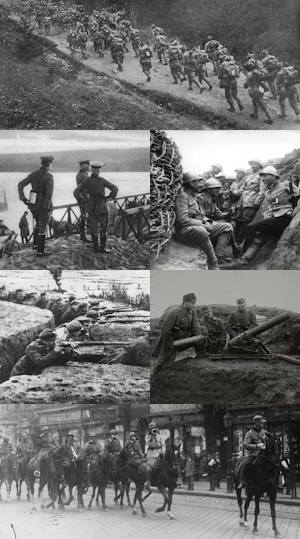Marsh Wars (Pacifica)
| Marsh Wars | |||||||
|---|---|---|---|---|---|---|---|
 (clockwise)
| |||||||
| |||||||
| Main belligerents | |||||||
|
|
| ||||||
| Commanders and leaders | |||||||
|
|
| ||||||
| Strength | |||||||
|
|
| ||||||
| Casualties and losses | |||||||
|
287,000 killed 380,000 wounded |
296,000 killed 320,000 wounded | ||||||
The Marsh Wars (Castonish: Guerras de las Marismas; Ezervulgish: Mocsarak háborúi) were a series of conflicts in the early 20th century as a result of a decade of crumbling Stoino-Ezervulgish relations. Open hostilities began on 5 September 1914 and would be marked by both swithering and static frontlines until 13 November 1918. The war would be named after the formation of marshes due to extreme weather conditions elevated through trench warfare. The conflict was one of Pacifica's first wars with the widespread use of trenches, chemical weapons and modern equipment.
Background
Both Stoinia and Ezervulge had become industrialised societies following the industrial revolution. However, the Ezervulgish King George II sought a policy of pan-Ezervulgism which brought it head-to-head with Stoinia which housed some 300,000 Ezervulgish in the Loreto, Corrientes and Norano provinces since the Hunyars' Sacking of Tolosa. These border provinces, in addition to hosting Ezervulgish minorities, were rich in coal and steel mines which would help fuel the further industrialisation of Ezervulge. It was hoped that this conquest of lands, would prove to
Strategy
Stoinia
Ezervulge

Events
First Marsh War
